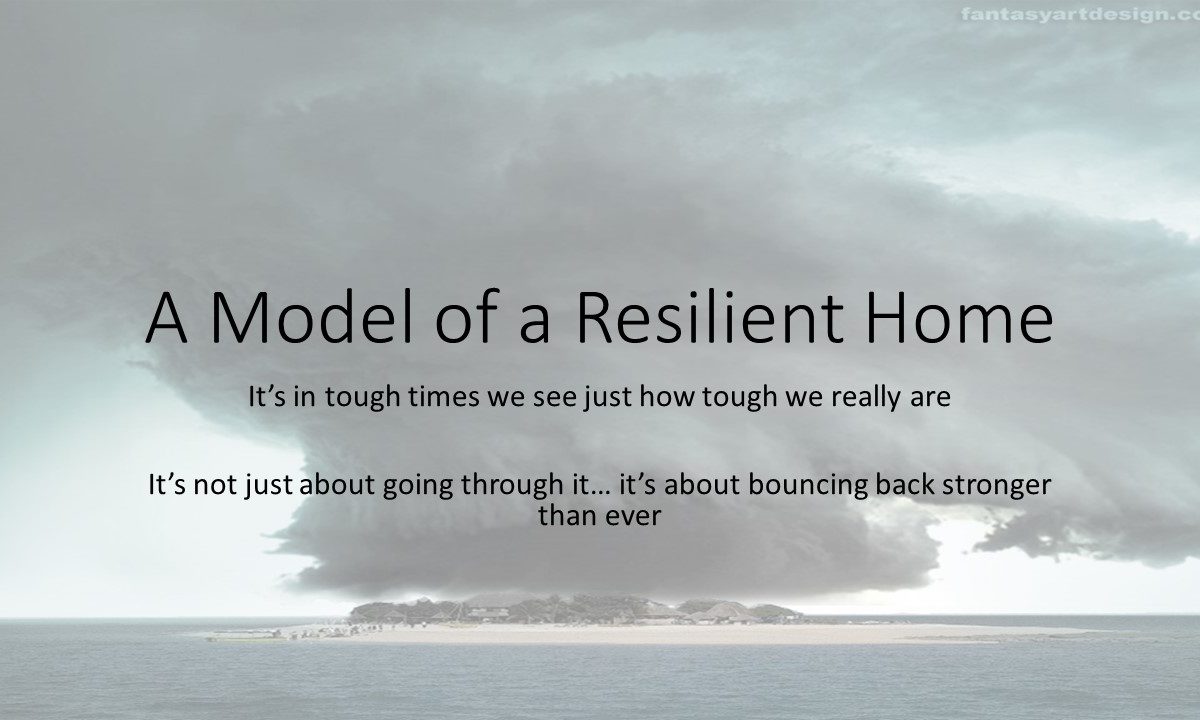
Modeling Resilience through gracious actions
The CEO of the home understands the value of modeling the behaviors we want to see in our children. That’s experiential learning through observation. They see what we do and then try it for themselves.
How we see and approach life impacts what our children see and feel about life. I remember a childhood friend who was super scared of thunder. It was nearly comical. But then, I sobered up when I saw her mom react to thunder. The reaction was just as over the top and as emotionally intense as my friend’s reaction was.
It was so deeply ingrained in my friend that even when the mom tried to correct the reaction and teach the child to remain cool when rain came it, the child didn’t believe the words. As soon as the thunder started to roll, the mom’s panic reaction took over.
Same thing can be said about resilience. Do we, as CEOs of the home, give up whenever things get tough? Do we quit projects quickly and try something else when things go wrong? Or do we model excellence from start to finish in all that we do? Do we model gratitude only when the project is complete or throughout the entire project? Do we find the good and positive even in the middle of the project when our nerves get frayed?
It’s OK to be frustrated, but how we express that frustration is critical to the growth of the observing child.
“I can’t believe this is happening to me again! I can’t win! This is such a pain!” are common refrains parents can easily catch themselves saying in front of difficulties. But… the lessons to the child or the spouse is hard to overcome with small speeches after the fact.
Our partners and our children get a good sense of how we handle stress and how reliable and confident we are in adversities. This colors how they will respond to us in all other situations.
Imagine working on a difficult task like taxes. A major problem came up. The family now faces some serious hard choices. The family then remembers how we reacted when we were faced with a less stressful situation. That memory now colors how they feel about our ability to handle this current ‘crisis’.
Dear CEOs of the home, you can just imagine the repercussions if the family does not feel confident in our ability to graciously handle the problem start to finish.
“This new unexpected opportunity gives me a chance to learn more about taxes” is a far more comforting attitude to witness. Not only does it set one up to win, it assures the others there is the expectancy of a positive resolution.
Let us all be mindful of how we vent about coming challenges or existing challenges. It can erode or build up confidence and resilience.
Another angle to this is the network of the family. Check this dialogue out.
“Hey Mario… I got an interesting situation that came up and I’m sure glad you’re one of those guys I can turn to for help. DO you have a minute?”
“Yeah Jill… I got a few minutes, what’s up?”
versus
“I already can tell from Jill’s facial expression, there is an earth shattering problem coming our way. Let’s move over and talk to the Trentons… maybe she’ll get the hint”
“I agree with you Mario. Last time, she carried on and on about this small problem and wasn’t grateful for the solution we found… and worse… ignored my advice and blamed me for her failings. Hurry, let’s get to the Trentons now!”
I think the point of grace with resilience is starting to take shape nicely. Even the availability of our network is affected by our attitude of gratitude (or the lack thereof) and our ability to see a project to completion (resilience).
As far as our children are concerned, CEOs of the home will use naturally occurring challenges to help increase a child’s endurance and resilience. Conversations about the right attitude to have in addition to modeling the right attitude will help the child along. Even creating certain artificial challenges can help the child grow.
By artificial challenges, we mean things like types of chores, types of responsibilities, types of learning challenges, etc. These things are done slightly above the child’s abilities to help them stretch forward and try. Of course, there are moments when the challenges have to be designed so they can win too. That way the child gets a sense that they can win whenever there is a challenge… not always one that is beyond their means.
The biggest lesson came from a mentor who said this… “praise the effort way more than the results”. I grew up in a family that was big on results. I totally get the point of the quote.
“Hi Marcy. I’m so glad you dug deep and stayed with this project until you finished it. I’m very proud of you. Shows your commitment to the responsibility you were trusted with”.
The child could have had a horrible result that they felt badly about. Instead of being punished for the bad result, a tactic many parents employ, the compliment on the journey’s commitment reinforces the value of working through any situation. The child is encouraged to value progress more than results.
What’s the catch?
Some failings is just the random draw of luck. You can do everything right, but in the end, you’re not where you wanted. Example. You could have studied all you wanted. The day of the test, the child is fighting a migraine. The results won’t be reflective of the effort. Punishing the less than stellar grade doesn’t help the child. But praising the study habit will help the child continue the right habits which will eventually result in better grades.
